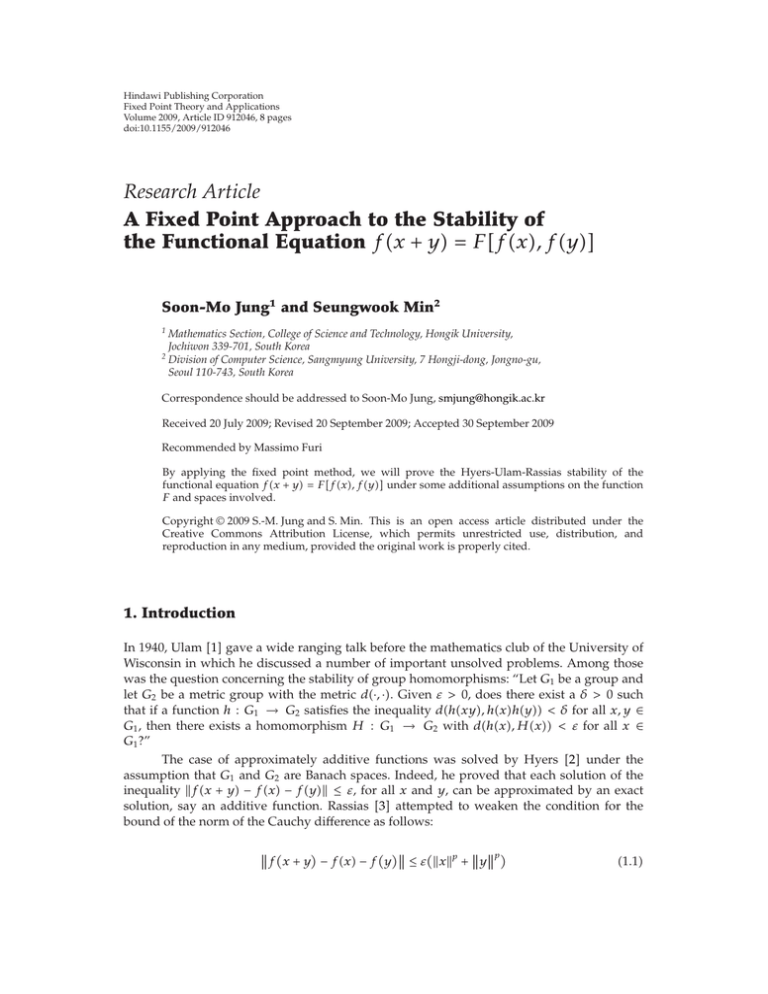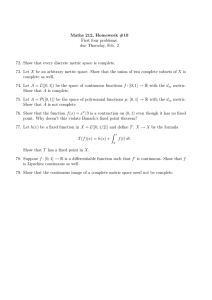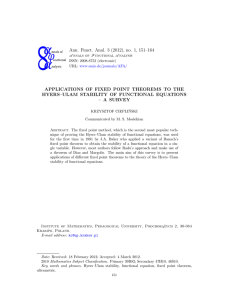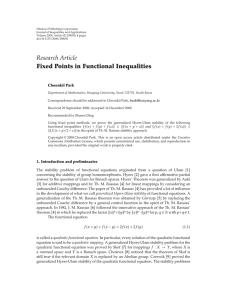Document 10858599
advertisement

Hindawi Publishing Corporation
Fixed Point Theory and Applications
Volume 2009, Article ID 912046, 8 pages
doi:10.1155/2009/912046
Research Article
A Fixed Point Approach to the Stability of
the Functional Equation fx y Ffx, fy
Soon-Mo Jung1 and Seungwook Min2
1
Mathematics Section, College of Science and Technology, Hongik University,
Jochiwon 339-701, South Korea
2
Division of Computer Science, Sangmyung University, 7 Hongji-dong, Jongno-gu,
Seoul 110-743, South Korea
Correspondence should be addressed to Soon-Mo Jung, smjung@hongik.ac.kr
Received 20 July 2009; Revised 20 September 2009; Accepted 30 September 2009
Recommended by Massimo Furi
By applying the fixed point method, we will prove the Hyers-Ulam-Rassias stability of the
functional equation fx y Ffx, fy under some additional assumptions on the function
F and spaces involved.
Copyright q 2009 S.-M. Jung and S. Min. This is an open access article distributed under the
Creative Commons Attribution License, which permits unrestricted use, distribution, and
reproduction in any medium, provided the original work is properly cited.
1. Introduction
In 1940, Ulam 1 gave a wide ranging talk before the mathematics club of the University of
Wisconsin in which he discussed a number of important unsolved problems. Among those
was the question concerning the stability of group homomorphisms: “Let G1 be a group and
let G2 be a metric group with the metric d·, ·. Given ε > 0, does there exist a δ > 0 such
that if a function h : G1 → G2 satisfies the inequality dhxy, hxhy < δ for all x, y ∈
G1 , then there exists a homomorphism H : G1 → G2 with dhx, Hx < ε for all x ∈
G1 ?”
The case of approximately additive functions was solved by Hyers 2 under the
assumption that G1 and G2 are Banach spaces. Indeed, he proved that each solution of the
inequality fx y − fx − fy ≤ ε, for all x and y, can be approximated by an exact
solution, say an additive function. Rassias 3 attempted to weaken the condition for the
bound of the norm of the Cauchy difference as follows:
f x y − fx − f y ≤ ε xp yp
1.1
2
Fixed Point Theory and Applications
and derived Hyers’ theorem for the stability of the additive mapping as a special case.
Thus in 3, a proof of the generalized Hyers-Ulam stability for the linear mapping between
Banach spaces was obtained. A particular case of Rassias’ theorem regarding the Hyers-Ulam
stability of the additive mapping was proved by Aoki see 4.
The stability concept that was introduced by Rassias’ theorem provided a large
influence to a number of mathematicians to develop the notion of what is known today
with the term Hyers-Ulam-Rassias stability of the linear mapping. Since then, the stability
of several functional equations has been extensively investigated by several mathematicians.
The terminology Hyers-Ulam-Rassias stability originates from these historical backgrounds.
The terminology can also be applied to the case of other functional equations. For more
detailed definitions of such terminologies, we can refer to 5–10.
Solutions of the functional equation
f x y F fx, f y
1.2
were investigated in 11, Section 2.2. The stability problem for a general equation of the
form fGx, y Hfx, fy was investigated by Cholewa 12 see also 13. Indeed,
Cholewa proved the superstability of that equation under some additional assumptions on
the functions and spaces involved.
In this paper, we will apply the fixed point method to prove the Hyers-Ulam-Rassias
stability of the functional equation 1.2 for a class of functions of a vector space into a Banach
space. To the best of authors’ knowledge, no one has yet applied the fixed point method for
studying the stability problems of 1.2. So, one of the aims of this paper is to apply the fixed
point theory to this case.
Throughout this paper, let K denote either R or C. Let X and Y be a vector space over
K and a Banach space over K, respectively.
2. Preliminaries
Let X be a set. A function d : X × X → 0, ∞ is called a generalized metric on X if and only
if d satisfies
M1 dx, y 0 if and only if x y;
M2 dx, y dy, x for all x, y ∈ X;
M3 dx, z ≤ dx, y dy, z for all x, y, z ∈ X.
Note that the only substantial difference of the generalized metric from the metric
is that the range of generalized metric includes the infinity. We now introduce one of
fundamental results of fixed point theory. For the proof, refer to 14. For an extensive theory
of fixed point theorems and other nonlinear methods the reader is referred to the book of
Hyers et al. 15.
Theorem 2.1. Let X, d be a generalized complete metric space. Assume that Λ : X → X is a strictly
contractive operator with the Lipschitz constant 0 < L < 1. If there exists a nonnegative integer k such
Fixed Point Theory and Applications
3
that dΛk1 f, Λk f < ∞ for some f ∈ X, then the followings are true:
a the sequence {Λn f} converges to a fixed point f ∗ of Λ;
b f ∗ is the unique fixed point of Λ in
X∗ g ∈ X : d Λk f, g < ∞ ;
2.1
c if g ∈ X∗ , then
d g, f ∗ ≤
1
d Λg, g .
1−L
2.2
Recently, Cădariu and Radu 16 applied the fixed point method to the investigation of
the Cauchy additive functional equation 17, 18. Using such a clever idea, they could present
a short, simple proof for the Hyers-Ulam-Rassias stability of Cauchy and Jensen functional
equations.
We remark that Isac and Rassias 19 were the first mathematicians who apply the
Hyers-Ulam-Rassias stability approach for the proof of new fixed point theorems.
3. Main Results
In this section, by using an idea of Cădariu and Radu see 16, 17, we will prove the
Hyers-Ulam-Rassias stability of the functional equation fx y Ffx, fy under the
assumption that F is a bounded linear transformation.
Theorem 3.1. Let X and Y, · be a vector space over K and a Banach space over K, respectively,
and let Y × Y, · 2 be a Banach space over K. Assume that F : Y × Y → Y is a bounded linear
transformation, whose norm is denoted by F, satisfying
FFu, u, Fv, v FFu, v, Fu, v
3.1
for all u, v ∈ Y and that there exists a real number κ > 0 with
u, u − v, v2 ≤ κu − v
3.2
for all u, v ∈ Y . Moreover, assume that ϕ : X × X → 0, ∞ is a given function satisfying
x y
ϕ ,
≤ ϕ x, y
2 2
3.3
for all x, y ∈ X. If κF < 1 and a function f : X → Y satisfies the inequality
f x y − F fx, f y ≤ ϕ x, y
3.4
4
Fixed Point Theory and Applications
for any x, y ∈ X, then there exists a unique solution f ∗ : X → Y of 1.2 such that
fx − f ∗ x ≤
1
ϕx, x
1 − κF
3.5
for all x ∈ X.
Proof. First, we denote by X the set of all functions h : X → Y and by d the generalized metric
on X defined as
d g, h inf C ∈ 0, ∞ : gx − hx ≤ Cϕx, x ∀x ∈ X .
3.6
Then, as in the proof of 20, Theorem 3.1, we can show that X, d is a generalized complete
metric space. Now, let us define an operator Λ : X → X by
x x ,h
Λhx F h
2
2
3.7
for every x ∈ X.
We assert that Λ is strictly contractive on X. Given g, h ∈ X, let C ∈ 0, ∞ be an
arbitrary constant with dg, h ≤ C, that is,
gx − hx ≤ Cϕx, x
3.8
for each x ∈ X. By 3.2, 3.3, 3.7, and 3.8, we have
x x x x Λg x − Λhx ,g
−F h
,h
F g
2
2
2
2
x x x x ≤ F g
,g
− h
,h
2
2
2
2
2
x
x −h
≤ Fκg
2
2
x x
≤ κFCϕ ,
2 2
3.9
≤ κFCϕx, x
for all x ∈ X, that is, in view of 3.6, dΛg, Λh ≤ κFdg, h for any g, h ∈ X, where κF
is the Lipschitz constant with 0 < κF < 1. Thus, Λ is strictly contractive.
We now verify that dΛf, f < ∞. If we substitute x/2 for x and y in 3.4, then it
follows from 3.3 and 3.7 that
fx − Λf x ≤ ϕ x , x ≤ ϕx, x
2 2
for every x ∈ X, that is, dΛf, f ≤ 1.
3.10
Fixed Point Theory and Applications
5
Taking k 0 in Theorem 2.1, a implies that there exists a function f ∗ : X → Y , which
is a fixed point of Λ, such that
lim d Λn f, f ∗ 0.
n→∞
3.11
Due to Theorem 2.1c, we get
d f, f ∗ ≤
1
1
d Λf, f ≤
,
1 − κF
1 − κF
3.12
which implies the validity of 3.5. According to Theorem 2.1b, f ∗ is the unique fixed point
of Λ with df, f ∗ < ∞.
We now assert that
n Λ f x y − F Λn f x, Λn f y ≤ κFn ϕ x, y
3.13
for all n ∈ N and x, y ∈ X. Indeed, it follows from 3.1, 3.2, 3.3, 3.4, and 3.7 that
Λf x y − F Λf x, Λf y x y x y xy
xy
F
f
,
f
−
F
F f
,f
,F f
,f
2
2
2
2
2
2
x y xy
f
≤ Fκ
−
F
f
,f
2
2
2 x y
≤ κFϕ ,
2 2
≤ κFϕ x, y
3.14
for any x, y ∈ X. We assume that 3.13 is true for some n ∈ N. Then, it follows from 3.1,
3.2, 3.3, 3.7, and 3.13 that
n1 Λ f x y − F Λn1 f x, Λn1 f y n xy n xy
F Λ f
, Λ f
2
2
x n x n y n y n
−F F Λ f
, Λ f
,F Λ f
, Λ f
2
2
2
2
n x y
x n y ≤ Fκ
, Λ f
− F Λn f
Λ f
2
2
2 x y
≤ κFn1 ϕ ,
2 2
n1 ≤ κF ϕ x, y ,
which proves the validity of 3.13 for all n ∈ N.
3.15
6
Fixed Point Theory and Applications
Finally, we prove that f ∗ x y Ff ∗ x, f ∗ y for any x, y ∈ X. Since F is
continuous as a bounded linear transformation, it follows from 3.11 and 3.13 that
∗
f x y − F f ∗ x, f ∗ y lim Λn f x y − F Λn f x, Λn f y n→∞
3.16
≤ lim κF ϕ x, y
n
n→∞
0,
which ends our proof.
Obviously, for nonnegative constants θ and p, ϕx, y θxp yp satisfies the
conditon 3.3.
Corollary 3.2. Let X and Y, · be a vector space over K and a Banach space over K, respectively,
and let Y × Y, · 2 be a Banach space over K. Assume that F : Y × Y → Y is a bounded linear
transformation, whose norm is denoted by F, satisfying the condition 3.1 and that there exists a
real number κ > 0 satisfying the condition 3.2. If κF < 1 and a function f : X → Y satisfies the
inequality
f x y − F fx, f y ≤ θ xp yp
3.17
for all x, y ∈ X and for some nonnegative real constants θ and p, then there exists a unique solution
f ∗ : X → Y of 1.2 such that
fx − f ∗ x ≤
2θ
xp
1 − κF
3.18
for all x ∈ X.
4. An Example
Assume that X Y C and consider the Banach spaces C, | · | and C × C, | · |2 , where we
|u|2 |v|2 for all u, v ∈ C. Let A and B be fixed complex numbers with
define |u, v|√
2
|A| |B| < 1/ 2 and let F : C × C → C be a linear transformation defined by
Fu, v Au Bv.
Then it is easy to show that F satisfies the condition 3.1.
4.1
Fixed Point Theory and Applications
7
If u and v are complex numbers satisfying |u, v|2 ≤ 1, then
|Fu, v| ≤ |A||u| |B||v| ≤ |A| |B|.
4.2
F sup{|Fu, v| : u, v ∈ C with |u, v|2 ≤ 1} ≤ |A| |B|,
4.3
Thus, we get
which implies the boundedness of the linear transformation F.
On the other hand, we obtain
|u, u − v, v|2 |u − v, u − v|2 for any u, v ∈ C; that is, we can choose
√
2|u − v|
4.4
√
2 for the value of κ and then we have
κF ≤
√
2|A| |B| < 1.
4.5
If a function f : C → C satisfies the inequality
f x y − F fx, f y ≤ ε
4.6
for all x, y ∈ C and for some ε > 0, then our Corollary 3.2 with θ ε/2 and p 0 implies
that there exists a unique function f ∗ : C → C such that
f ∗ x y F f ∗ x, f ∗ y
4.7
for all x, y ∈ C and
fx − f ∗ x ≤
1−
√
ε
2|A| |B|
4.8
for any x ∈ C.
Acknowledgments
The authors would like to express their cordial thanks to the referees for their useful
comments which have improved the first version of this paper. This work was supported
by the National Research Foundation of Korea Grant funded by the Korean Government no.
2009-0071206.
8
Fixed Point Theory and Applications
References
1 S. M. Ulam, A Collection of Mathematical Problems, Interscience Tracts in Pure and Applied
Mathematics, no. 8, Interscience, New York, NY, USA, 1960.
2 D. H. Hyers, “On the stability of the linear functional equation,” Proceedings of the National Academy of
Sciences, vol. 27, pp. 222–224, 1941.
3 Th. M. Rassias, “On the stability of the linear mapping in Banach spaces,” Proceedings of the American
Mathematical Society, vol. 72, no. 2, pp. 297–300, 1978.
4 T. Aoki, “On the stability of the linear transformation in Banach spaces,” Journal of the Mathematical
Society of Japan, vol. 2, pp. 64–66, 1950.
5 G. L. Forti, “Hyers-Ulam stability of functional equations in several variables,” Aequationes
Mathematicae, vol. 50, no. 1-2, pp. 143–190, 1995.
6 D. H. Hyers, G. Isac, and Th. M. Rassias, Stability of Functional Equations in Several Variables, Progress
in Nonlinear Differential Equations and Their Applications, Birkhäuser, Boston, Mass, USA, 1998.
7 D. H. Hyers and Th. M. Rassias, “Approximate homomorphisms,” Aequationes Mathematicae, vol. 44,
no. 2-3, pp. 125–153, 1992.
8 S.-M. Jung, “Hyers-Ulam-Rassias stability of functional equations,” Dynamic Systems and Applications,
vol. 6, no. 4, pp. 541–565, 1997.
9 S.-M. Jung, Hyers-Ulam-Rassias Stability of Functional Equations in Mathematical Analysis, Hadronic
Press, Palm Harbor, Fla, USA, 2001.
10 Th. M. Rassias, “On the stability of functional equations and a problem of Ulam,” Acta Applicandae
Mathematicae, vol. 62, no. 1, pp. 23–130, 2000.
11 J. Aczél, Lectures on Functional Equations and Their Applications, vol. 19 of Mathematics in Science and
Engineering, Academic Press, New York, NY, USA, 1966.
12 P. W. Cholewa, “The stability problem for a generalized Cauchy type functional equation,” Revue
Roumaine de Mathématiques Pures et Appliquées, vol. 29, no. 6, pp. 457–460, 1984.
13 G. L. Forti, “An existence and stability theorem for a class of functional equations,” Stochastica, vol. 4,
no. 1, pp. 23–30, 1980.
14 B. Margolis and J. Diaz, “A fixed point theorem of the alternative, for contractions on a generalized
complete metric space,” Bulletin of the American Mathematical Society, vol. 74, pp. 305–309, 1968.
15 D. H. Hyers, G. Isac, and Th. M. Rassias, Topics in Nonlinear Analysis & Applications, World Scientific,
River Edge, NJ, USA, 1997.
16 L. Cădariu and V. Radu, “On the stability of the Cauchy functional equation: a fixed point approach,”
Grazer Mathematische Berichte, vol. 346, pp. 43–52, 2004.
17 L. Cădariu and V. Radu, “Fixed points and the stability of Jensen’s functional equation,” Journal of
Inequalities in Pure and Applied Mathematics, vol. 4, no. 1, article 4, 2003.
18 V. Radu, “The fixed point alternative and the stability of functional equations,” Fixed Point Theory,
vol. 4, no. 1, pp. 91–96, 2003.
19 G. Isac and Th. M. Rassias, “Stability of ψ-additive mappings: applications to nonlinear analysis,”
International Journal of Mathematics and Mathematical Sciences, vol. 19, no. 2, pp. 219–228, 1996.
20 S.-M. Jung and Z.-H. Lee, “A fixed point approach to the stability of quadratic functional equation
with involution,” Fixed Point Theory and Applications, vol. 2008, Article ID 732086, 11 pages, 2008.




